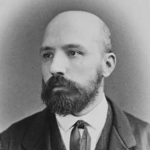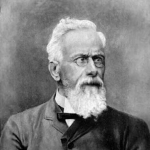Background
Francesco Brioschi was born on December 22, 1824, in Milan, Lombardo-Veneto (now Italy), the son of Paola Brioschi and Camilla Seblis.

University of Pavia, Corso Str. Nuova, 65, 27100 Pavia PV, Italy
Francesco Brioschi studied at the University of Pavia, and graduated in 1845 from the university, where he was a student of Antonio Bordoni.
Accademia dei Lincei, Palazzo Corsini, Via della Lungara, 10, 00165 Roma RM, Italy
In 1870 Francesco Brioschi became a member of the Accademia dei lincei and in 1884 he succeeded Quintino Sella as president of the National Academy of the Lincei.
Italy
Francesco Brioschi also received the Civil Order of Savoy.
Cimitero Monumentale di Milano, Piazzale Cimitero Monumentale, 20154 Milano MI, Italy
The grave of Italian matematician Francesco Brioschi at the Cimitero Monumentale di Milano, Italy.






educator mathematician politician scientist
Francesco Brioschi was born on December 22, 1824, in Milan, Lombardo-Veneto (now Italy), the son of Paola Brioschi and Camilla Seblis.
Brioschi studied at the University of Pavia, which is 32 km south of his home town of Milan, and an ancient institution in the mid 19th century being founded in 1361.
Brioschi graduated from the University of Pavia in 1845 when he received a doctorate after submitting a thesis which had been directed by Antonio Bordoni.
From 1852 to 1861 Brioschi was a professor of applied mathematics at the University of Pavia, teaching theoretical mechanics, civil architecture, and hydraulics. He was the general secretary of the Ministry of Education in 1861-1862, a senator from 1865, and, from 1870 until 1882, a member of the Executive Council of the Ministry of Education. In 1863 Brioschi organized the Istituto Técnico Superiore in Milan, serving as director and professor of mathematics and hydraulics until his death.
From the beginning of his career, Brioschi strove to overcome the backwardness of Italian mathematics, to popularize new scientific trends, and to raise the quality of the teaching of mathematics in secondary schools and universities. He published many essays and reviews, and participated in the organization of the journal Annali di matemática pura ed applicata, heading its editorial staff from 1867 until his death (until 1877 in conjunction with Cremona). He also helped to organize the journal Politécnico.
In his original papers, Brioschi appears as a virtuoso in computation, as an analyst, and as an algebraist. In the works of his most fruitful decade (1851-1860) he widely applied and developed the still new theory of determinants. His Teoría dei determinanti (1854) was the first nonelementary statement of the theory and its basic applications. Brioschi devoted several important papers, following Caley, Sylvester, and Hermite, to the then developing theory of forms of two or more variables. He applied exclusively algebraic means of solution to such questions as the deduction of equations in partial derivatives for the discriminant of a binary form and for the resultant of two such forms. A significant part of his results in this area was included in a monograph published in the first four volumes of Annali di matemática.
In these same years, Brioschi added new results to the theory of the transformation of elliptic and Abelian functions. In his greatest achievement, following Hermite and simultaneously with Kronecker, he applied elliptical modular functions to the solution of fifth-degree equations. At the same time, Brioschi popularized Gauss’s theory of surfaces in Italy and brought forth, in connection with this, geometric papers.
During the 1860’s and 1870’s Francesco Brioschi continued his work in algebra and analysis in traditional directions, using the Weierstrass theory of elliptic functions. From these viewpoints, he addressed himself to the theory of differential equations and, in the 1880’s, to the theory of hyperelliptic functions. His second great achievement relates to this latter period: the solution of sixth-degree equations with the aid of hyperelliptic functions.
In mechanics Brioschi dealt with problems of statics, proving Moebius’ results by analytic means; with the integration of equations in dynamics, according to Jacobi’s method; with hydrostatics; and with hydrodynamics. His work as a hydraulic engineer was significant, although it is reflected comparatively little in his publications. Brioschi used the findings of a series of major projects or participated in the projects’ development - for example, in the regulation of the Po and Tiber (which goals remained unaccomplished). Two more of Brioschi’s works should be mentioned: with Betti, he brought out a treatment of the first six books of Euclid’s Elements for secondary schools, and he edited Leonardo da Vinci’s Codice Atlántico, an important source for the history of science and technology.
An adherent of pure mathematics, Brioschi highly valued its significance in application and allotted to it a significant place in technical education, emphasizing the great role of the latter in the development of national industry. At the same time, he insisted on the value of the humanities and, simultaneously with his founding of the Politechnicum, he organized the Accademia Scientifica-Litteraria in Milan.
In addition to the publication of the Codice Atlántico, Brioschi produced several important articles on contemporary mathematicians.
Francesco Brioschi is remembered as a mathematician, who studied the problem of solving fifth and sixth-degree equations using elliptic functions and worked at the Polytechnic University until his death. He is also remembered as a distinguished teacher: among his students at the University of Pavia, there were Eugenio Beltrami, Luigi Cremona, and Felice Casorati.
The Brioschi formula, a formula introduced by Francesco Brioschi for Gaussian curvature, was named in his honor.
In addition, Francesco Brioschi was a member of the Saint Petersburg Academy of Sciences (now the Russian Academy of Sciences), the Royal Swedish Academy of Sciences, the American Academy of Arts and Sciences, the Royal Prussian Academy of Sciences and the Bavarian Academy of Sciences and Humanities.
Francesco Brioschi was a brilliant analyst with algebraic propensities and possessed rare mobility of thought that responded to new ideas from their very inception. This enabled him to enrich science with new results for half a century.

Antonio Luigi Gaudenzio Giuseppe Cremona was an Italian mathematician, whose life was devoted to the study of geometry and reforming advanced mathematical teaching in Italy. He notably enriched our knowledge of algebraic curves and algebraic surfaces.

Francesco Brioschi brought out a treatment of the first six books of Euclid’s Elements for secondary schools with Enrico Betti.
